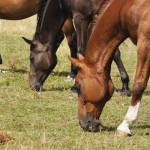Cecal Microbial Populations Could Be Unique To Individual Horses

Even novice horse enthusiasts know that all horses and ponies have chestnuts, those callous growths that appear on the inside of each leg, above the knee of forelegs and below the hock of hind legs. These chestnuts are thought to be as individual to horses as fingerprints are to humans. But could horses have even more individuality than once thought? This time the differences might be internal.
Ruminant researchers at the U.S. Dairy Forage Research Center in Madison, Wisconsin recently published studies that suggested the microbial population of a cow’s rumen could be as unique as her DNA. The rumen is the most voluminous chamber of the cow’s four-compartment stomach, and it contains countless microorganisms that work to break down forages into vital nutrients.
Ruminal fluid from two cannulated cows was studied and bacterial community composition (BCC) developed for each cow. Both cows then underwent a one-time exchange of nearly all of their rumen contents (>95%). Following the exchange, ruminal pH and volatile fatty acid (VFA) composition returned to pre-exchange levels within 24 hours. BCC returned to distinct pre-exchange values, but this took longer (two weeks for one cow and two months for the other).
According to researchers, this study shows that pH and VFA levels can be reestablished quickly in the bovine rumen despite sudden changes, and that BCC might be specific to its host.
The horse possesses an organ similar to the rumen. Called the cecum, it is part of the horse’s hindgut. In healthy horses, the cecum maintains a robust population of bacteria, protozoa, and fungi that aid in the fermentation of dietary fiber, which fuels the production of VFAs, an important source of energy for the horse. Because fermentation gives off heat, this process keeps the horse warm in the coldest of environments, which is why feeding forage is critical in winter.
Though equine digestive experts are still unclear if the microbial profile of a horse’s cecum is unique, they are convinced beyond a doubt that a well-fed, functioning cecum is paramount for overall health and well-being.
Horse owners should avoid upsetting the balance of microorganisms in the cecum of the horse. Minimizing changes to the horse’s feeding program is the first line of defense. When changes are necessary, they should be done slowly so all digestive organs, not just the cecum, have time to adapt.
During particularly stressful times, such as during sickness, a horse may be given a probiotic to boost the microbial population of the cecum. A probiotic preparation introduces live microorganisms into the cecum, thus increasing fermentation capability. Check with an equine nutritionist or a veterinarian to determine if a probiotic is needed.








